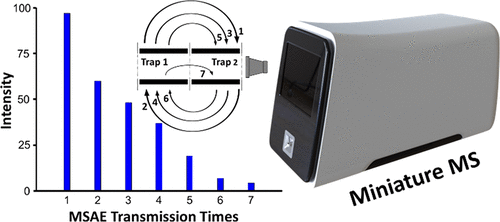Tandem Analysis by a Dual-Trap Miniature Mass Spectrometer
Miniature mass spectrometers are of an increasing interest for in in-situ analyses and their coupling with the ambient ionization sources is a valid path for direct analysis of complex samples. In this study, a miniature mass spectrometer using discontinuous atmospheric pressure interface was developed with a dual-LIT (linear ion trap) configuration. The comprehensive scan modes were enabled for tandem mass spectrometry analysis, which are critical for high quality qualitative and quantitative analysis. A real-time pressure control was implemented to facilitate the ion transfer and collision induced dissociation (CID). Beam-type CID could be performed for tandem analysis at a high number of stages. In-trap CID at high q could also be performed with the fragment ions accumulated in a second trap. A precursor ion scan mode for analyzing target analytes has also been demonstrated.

A miniature mass spectrometer with dual linear ion traps and discontinuous atmospheric pressure interface has been built for developing comprehensive scan modes for tandem mass spectrometry analysis. This study represents a unique attempt for performing complex mass analysis functions without the traditional instrumentation of large scales and complex configurations. Tandem-in-space ion manipulations were enabled using the dual-LIT configuration, facilitated with the real-time pressure control. High energy beam-type CID could be performed in addition to the low energy in-trap CID and MSn with n>2 were realized using two LITs in a ping-pang fashion with CID. The development of a variety of scan modes for the miniature MS system shows the potential of mass spectrometers with simple configurations and small sizes for performing comprehensive qualitative and quantitative analysis. This is important for direct analysis of complex samples using minimal or no sample pretreatment.
Anal. Chem. 2019, 91, 2, 1391-1398 (IF: 6.8)


